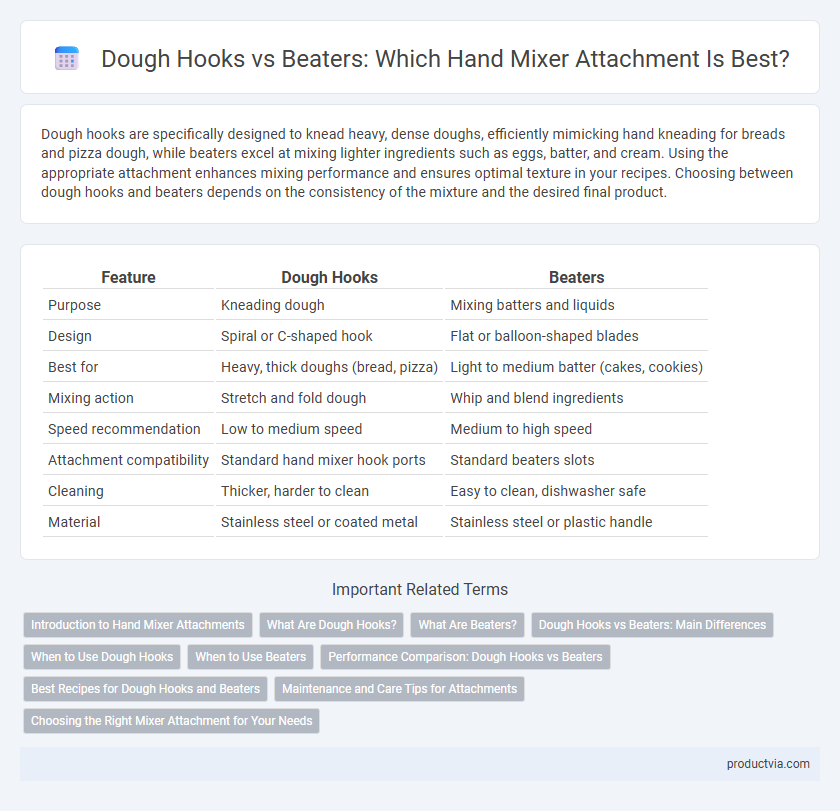Dough hooks are specifically designed to knead heavy, dense doughs, efficiently mimicking hand kneading for breads and pizza dough, while beaters excel at mixing lighter ingredients such as eggs, batter, and cream. Using the appropriate attachment enhances mixing performance and ensures optimal texture in your recipes. Choosing between dough hooks and beaters depends on the consistency of the mixture and the desired final product.
Table of Comparison
| Feature | Dough Hooks | Beaters |
|---|---|---|
| Purpose | Kneading dough | Mixing batters and liquids |
| Design | Spiral or C-shaped hook | Flat or balloon-shaped blades |
| Best for | Heavy, thick doughs (bread, pizza) | Light to medium batter (cakes, cookies) |
| Mixing action | Stretch and fold dough | Whip and blend ingredients |
| Speed recommendation | Low to medium speed | Medium to high speed |
| Attachment compatibility | Standard hand mixer hook ports | Standard beaters slots |
| Cleaning | Thicker, harder to clean | Easy to clean, dishwasher safe |
| Material | Stainless steel or coated metal | Stainless steel or plastic handle |
Introduction to Hand Mixer Attachments
Hand mixer attachments significantly influence the versatility and efficiency of your kitchen tasks. Dough hooks are specialized for kneading heavier doughs, providing consistent and thorough mixing without overworking the batter. Standard beaters excel at whipping cream, mixing cake batter, and general-purpose blending, offering speed and aeration for lighter mixtures.
What Are Dough Hooks?
Dough hooks are specialized hand mixer attachments designed to knead heavy, dense doughs like bread or pizza dough by mimicking the manual kneading process. Their spiral or C-shaped design efficiently stretches and folds dough, promoting gluten development without overworking the mixture. Using dough hooks helps achieve consistent texture and elasticity essential for baked goods requiring thorough kneading.
What Are Beaters?
Beaters are the most common hand mixer attachments designed for mixing lighter ingredients like batter, eggs, and cream. They feature a wire or paddle shape that efficiently incorporates air, resulting in smooth and fluffy textures for cakes and whipped items. Unlike dough hooks, beaters are not suitable for kneading heavy doughs, as they cannot handle the dense consistency required for bread or pasta dough preparation.
Dough Hooks vs Beaters: Main Differences
Dough hooks and beaters are essential hand mixer attachments designed for distinct purposes; dough hooks efficiently knead heavy, elastic dough by mimicking hand-kneading movements, while beaters are ideal for whipping, mixing, and blending lighter ingredients like batter or cream. Dough hooks have a spiral or hook shape that enables thorough gluten development without overworking the dough, whereas beaters feature a wire design for incorporating air and achieving smooth, fluffy mixtures. Selecting the appropriate attachment enhances mixing performance and ensures optimal texture for specific recipes, whether bread dough or cake batter.
When to Use Dough Hooks
Dough hooks are ideal for kneading heavy, dense doughs such as bread, pizza, and pasta, where gluten development is crucial for texture. These spiral or C-shaped attachments mimic hand kneading, efficiently combining ingredients without overworking the mix or incorporating excess air. Using dough hooks reduces strain on the hand mixer's motor when handling thick batters, ensuring consistent dough formation and optimal elasticity.
When to Use Beaters
Beaters for hand mixers are ideal for mixing cake batter, whipping cream, and combining lighter ingredients that require aeration and smooth blending. They efficiently incorporate air into mixtures, resulting in fluffy textures and consistent consistency for desserts and frosting. Avoid using beaters for heavy doughs, as their design is not suited for kneading dense mixtures.
Performance Comparison: Dough Hooks vs Beaters
Dough hooks excel in kneading heavy, dense doughs by mimicking hand-kneading movements, ensuring optimal gluten development and consistent texture. Beaters perform best with lighter mixtures like cake batter, whipping air into the mix for a fluffy, smooth consistency. Choosing between dough hooks and beaters depends on the recipe's texture requirements and ingredient density for maximum mixing performance.
Best Recipes for Dough Hooks and Beaters
Dough hooks excel at kneading bread, pizza, and pasta dough, providing thorough mixing for dense, heavy ingredients to create elastic, well-developed gluten strands. Beaters are ideal for whipping cake batter, cookie dough, and light mixtures such as meringues and frostings, ensuring smooth, airy textures by incorporating air efficiently. Selecting the right attachment enhances recipe outcomes by matching the tool's function with specific dough or batter requirements.
Maintenance and Care Tips for Attachments
Dough hooks require thorough cleaning after each use to prevent dough residue from hardening, which can affect performance and hygiene; soaking in warm soapy water helps loosen stuck particles. Beaters are generally easier to clean, but inspecting for bent or damaged wires ensures safe operation and efficient mixing. Both attachments benefit from drying completely before storage to prevent rust and maintain longevity.
Choosing the Right Mixer Attachment for Your Needs
Dough hooks are specifically designed for kneading heavy, dense doughs like bread or pizza, providing the necessary power and shape to effectively develop gluten without overworking the mixture. Beaters, on the other hand, excel at mixing lighter batters, whipping cream, and combining ingredients for cakes or cookies, offering faster aeration and smooth consistency. Selecting the right attachment depends on the type of recipe and texture desired, ensuring optimal mixing performance and culinary results.
Dough hooks vs Beaters for Hand Mixer Attachments Infographic

 productvia.com
productvia.com